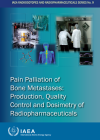Nuclear medicine therapy uses radiopharmaceuticals targeting specific tumours, such as thyroid, lymphomas or bone metastases, delivering radiation to tumorous lesions as part of a therapeutic strategy to cure, mitigate or control the disease. It can be used either on selective targets or throughout the entire body.
Radionuclide therapy
Targeting the tumour
The advancements in medical technology have led to a dramatic surge in the development and availability of new cancer treatments. The treatment of cancer involves different strategies, such as chemotherapy, surgery, radiation therapy and, most recently, targeted therapies, such as the use of radionuclide-based therapies employed in nuclear medicine. External radiotherapy with ionizing radiation is the most frequently employed radiation treatment of cancer patients. In this approach, the primary tumour and a limited area around it is treated through irradiation with high-energy X-rays.
Another treatment option available for certain types of cancer is the use of targeted radionuclide therapy, which is based on administering radioactive substances to patients. Just like chemotherapy, this therapy is a systemic treatment, reaching cells throughout the body by travelling through the bloodstream. However, unlike chemotherapy, these radioactive substances specifically target diseased cells, thus reducing potential side effects.
Radiopharmaceuticals
The radiopharmaceuticals suited for therapeutic purposes are those that strongly bind with the tumour – also known as vehicles with a high tumour affinity. They can transport targeted doses of radiation directly to the tumours and its metastases, thereby sparing normal healthy tissue. The choice of the molecule that carries the radiation to the tumour is determined by its affinity – or binding power – to the tumour’s target structures, such as antigens or receptors. The ionizing radiation emitted by radionuclides linked to the carrier kill cancer cells by damaging their DNA, causing the tumours to shrink.
An ideal radiopharmaceutical for therapeutic purposes should:
- act exclusively in the cells of malignant tumours;
- reach all the cells of malignant tumours wherever they are localized;
- leave healthy tissues and organs unhurt while bringing maximum doses of radiation to the tumour; and
- eliminate malignant tumour cells with great effectiveness.
How the therapy works
The biological action of a radiopharmaceutical is determined by the form of ionizing radiation emitted by the radionuclide. While imaging procedures in nuclear medicine require radionuclides that will emit γ (gamma) radiation able to penetrate the body, a different class of radionuclides possessing optimal relative biological effectiveness is needed for radionuclide therapy. The radionuclides best suited for tumour therapy are those emitting ionizing radiation with short penetration into the tissue, such as α (alpha) or β (beta) emitters, which release their energy in the proximity of their targets.








